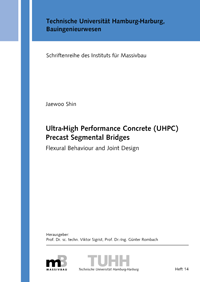
Shop : Recommendation
Shop
Recommendation
48,80 €ISBN 978-3-8440-5042-4Softcover202 pages187 figures352 g24 x 17 cmEnglishThesis
February 2017
Jaewoo Shin
Ultra-High Performance Concrete (UHPC) Precast Segmental Bridges
Flexural Behaviour and Joint Design
Bridges have been built for thousands of years. Nevertheless, new construction methods which enable a very fast erection, a structure which can adapt to the increasing traffic loads, and new materials which improve the durability are still required. An externally post-tensioned precast segmental box girder bridge (PSB) is one solution to these requirements. The great advantages of this type of bridge have made them the preferred construction method for many great elevated highway projects, especially in South East Asia. Normal concrete, having a compressive strength of around fck ≈ 40 MPa, had been used for these structures. In the last years, concrete having fck > 160 MPa has been developed. This Ultra High Performance Concrete (UHPC) shows significant advantages with regard to strength and durability. While the mechanical properties of UHPC are known, the applications for it are progressing very slowly because of high material cost and lack of design and experience. Thus, this research work focuses on the structural behaviour and the design of UHPC precast segmental bridges.
First, this research gives a brief overview of the material characteristics of UHPC and the suitability for application to segmental bridge construction. The design recommendations of various countries are analyzed. Some examples of UHPC segmental bridges are presented and discussed.
The results from a full-scale test of a Precast Segmental Bridge (PSB) are used to verify a non-linear FE-model of the structure. This numerical model is then adapted to UHPC bridges, having smaller cross-section heights and slab thicknesses. An intense parametric study (slenderness ratio, thickness of slabs, E-modulus, prestressing force) is conducted to find the most appropriate cross-section for UHPC-PSB. Based on these investigations, a multi-cell box girder with stiffeners is proposed as a viable UHPC precast segmental bridge. The structural behavior, e.g. the deflection, the width of the joint opening after decompression, the compressive and shear stress distribution and the increase of tendon stress for this single span structure is analyzed and discussed. It is demonstrated, that a UHPC-PSB shows significant advantages, such as the significantly reduced dead load, compared to constructions with normal strength concrete.
The capacity of the dry joints between adjacent segments is of crucial importance for the safety of the structure. It is doubtful whether the known design approaches for normal strength concrete can be used for UHPC structures. Therefore UHPC shear-key tests are conducted. Through the comparison of existing designs for UHPC shear-keys, and non-linear FE-simulations, a new design method for shear resistance of UHPC shear-key is proposed.
First, this research gives a brief overview of the material characteristics of UHPC and the suitability for application to segmental bridge construction. The design recommendations of various countries are analyzed. Some examples of UHPC segmental bridges are presented and discussed.
The results from a full-scale test of a Precast Segmental Bridge (PSB) are used to verify a non-linear FE-model of the structure. This numerical model is then adapted to UHPC bridges, having smaller cross-section heights and slab thicknesses. An intense parametric study (slenderness ratio, thickness of slabs, E-modulus, prestressing force) is conducted to find the most appropriate cross-section for UHPC-PSB. Based on these investigations, a multi-cell box girder with stiffeners is proposed as a viable UHPC precast segmental bridge. The structural behavior, e.g. the deflection, the width of the joint opening after decompression, the compressive and shear stress distribution and the increase of tendon stress for this single span structure is analyzed and discussed. It is demonstrated, that a UHPC-PSB shows significant advantages, such as the significantly reduced dead load, compared to constructions with normal strength concrete.
The capacity of the dry joints between adjacent segments is of crucial importance for the safety of the structure. It is doubtful whether the known design approaches for normal strength concrete can be used for UHPC structures. Therefore UHPC shear-key tests are conducted. Through the comparison of existing designs for UHPC shear-keys, and non-linear FE-simulations, a new design method for shear resistance of UHPC shear-key is proposed.
Keywords: Precast Segmental Bridge; Ultra-High Performance Concrete; UHPC
Schriftenreihe des Instituts für Massivbau der TUHH
Edited by Prof. Dr. sc. techn. Viktor Sigrist and Prof. Dr.-Ing. Günter Rombach, Hamburg
Volume 14
The recommendation will be sent by email to the address you provide below.
Fields marked with * are mandatory! Please fill them out completely.
Shaker Verlag GmbH
Am Langen Graben 15a
52353 Düren
Germany
Am Langen Graben 15a
52353 Düren
Germany
Mon. - Thurs. 8:00 a.m. to 4:00 p.m.
Fri. 8:00 a.m. to 3:00 p.m.
Fri. 8:00 a.m. to 3:00 p.m.
Contact us. We will be happy to help you.



